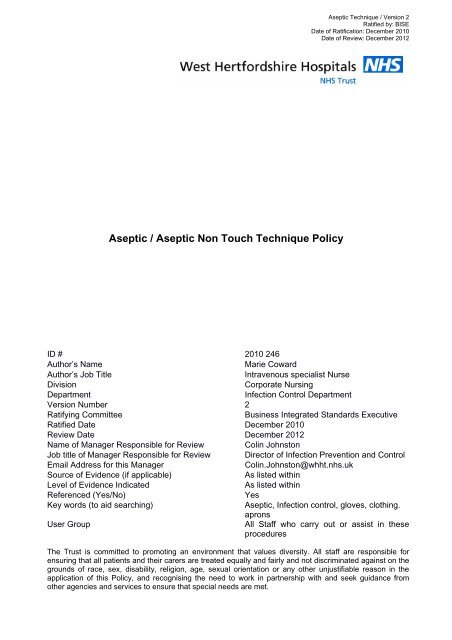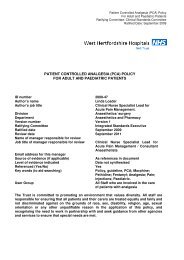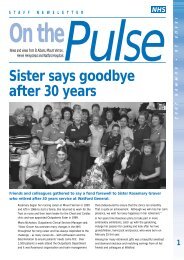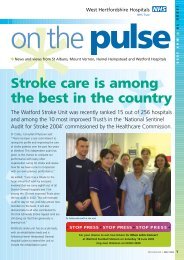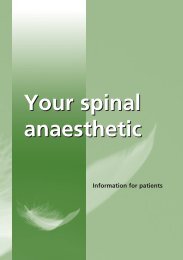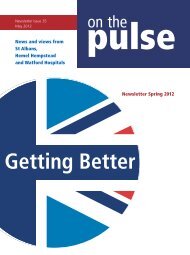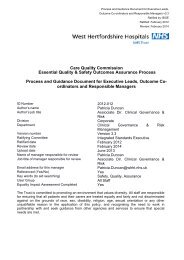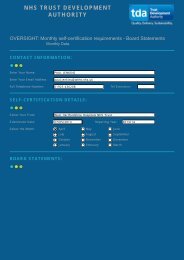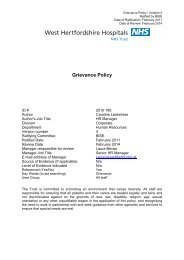Aseptic Technique - West Hertfordshire Hospitals NHS Trust
Aseptic Technique - West Hertfordshire Hospitals NHS Trust
Aseptic Technique - West Hertfordshire Hospitals NHS Trust
You also want an ePaper? Increase the reach of your titles
YUMPU automatically turns print PDFs into web optimized ePapers that Google loves.
<strong>Aseptic</strong> <strong>Technique</strong> / Version 2Ratified by: BISEDate of Ratification: December 2010Date of Review: December 20121. IntroductionIn 2008 the department of Health updated The Health and Social Care Act (Code of Practicefor the <strong>NHS</strong> on the prevention and control of Healthcare associated infections and relatedguidance), which was implemented from 1 st April 2010. Within this document is a code ofpractice that healthcare organisations are expected to comply with. One of the Clinical careprotocols is <strong>Aseptic</strong> technique and states:• Clinical procedures should be carried out in a manner that maintains and promotes theprinciples of asepsis• Education and training and assessment in the aseptic technique should be provided to allpersons undertaking such procedures• The technique should be standardised across the organisation• Audit should be undertaken to monitor compliance with aseptic techniqueIt is the responsibility of all clinicians who facilitate training within the trust that involves any form ofaseptic procedure to ensure it is incorporated within their training programme.2. Definition of an <strong>Aseptic</strong> <strong>Technique</strong><strong>Aseptic</strong> technique is defined as a set of specific practices and procedures performed undercarefully controlled conditions with the goal of minimizing contamination by preventing the transferof pathogens from one person to another (Flores 2008).This Policy should be read in conjunction with the following Policies:• Management of Infection Prevention & Control Policy (February 2008)• All other related Infection Control Policies as outlined within the Management ofInfection Prevention & Control Policy under Section 6.2. (Please refer to Section 6.2 forthe list of Policies and dates)2.1 Principles of <strong>Aseptic</strong> <strong>Technique</strong>• Prepare the environment including decontamination of the working surface or tray to beused with a detergent/disinfectant eg. Chlorclean or disinfectant wipes.• The extent of drape use and protective clothing will also depend on the type ofprocedure and its complexity and the experience of the person undertaking theprocedure. For example:ooolarge drapes and maximal barrier precautions are always required for surgicalprocedures and central venous catheter insertions.sterile gloves and a plastic apron for all surgical wounds with exception ofperianal fistulas, incision and drainage woundsclean non sterile gloves and a plastic apron are adequate for phlebotomy,cannulation and IV drug administration.• Assemble all appropriate packaged sterile items and other necessary non sterileequipment for the procedure on the bottom shelf of trolley or around the procedure traybeing used. Check packaging is intact and expiry date has not been exceeded.Page 3 of 10
<strong>Aseptic</strong> <strong>Technique</strong> / Version 2Ratified by: BISEDate of Ratification: December 2010Date of Review: December 2012• When opening packaged sterile items, such as needles and syringes, do so by peelingback the packaging and not by pushing the item through the sterile package.• If possible, avoid exposing and/or dressing wounds or performing any other asepticprocedure for at least 30 minutes after bed making or domestic cleaning has concluded.• <strong>Aseptic</strong> procedures should not be undertaken during times of increased activity egvisiting times• Depending on the procedure you can remove any soiled dressings carefully with nonsterile gloves or using the sterile yellow bag within the dressing pack(a large amount ofmicro organisms are shed into the air)• Expose wounds for the minimum time to avoid contamination and maintaintemperature.• Remove gloves and wash hands before applying sterile gloves. NEVER apply handhygiene products to your gloved hands.• Perform the procedure, including skin preparation where applicable, avoiding accidentalcontamination of sterile equipment/vulnerable site.• Should contamination occur the procedure will need to be started again with freshequipment/products.• Solutions used to irrigate/ cleanse wounds must be sterile2.2 <strong>Aseptic</strong> Non Touch <strong>Technique</strong> (ANTT)When clean, non sterile gloves are worn rather than sterile gloves a ‘non touch’ aseptictechnique is required to maintain asepsis. This means not touching key parts of theequipment (and the patient) used during the procedure with your non sterile gloves. Ingeneral, this means avoiding touching, what are termed as “key parts”:• Sterile equipment that will be used invasively e.g. the tip of the syringe or hub ofcannula extension set.• The surface of a sterile dressing that will be in direct contact with the wound• Seals of IV connectors that have been disinfected prior to administration ofmedication• Skin after it has been disinfected prior to phlebotomy or cannulation• Open wounds and invasive devise sites3. Essential Actions for all Procedures• Dispose of single-use items after one use• Dispose of single patient use items when no longer required/ visibly soiled or haveexpired there limit of use identified by the manufacturer.• Ensure single patient use items are decontaminated in line with manufacturer guidance.• Decontaminate re-usable items according to local policy and manufacturer’sinstructions• Store sterile equipment in clean, dry conditions, off the floor• Dispose of waste as per local policy• Minimise interventions that result in a break in closed systems e.g. manipulation of IVlines.Page 4 of 10
<strong>Aseptic</strong> <strong>Technique</strong> / Version 2Ratified by: BISEDate of Ratification: December 2010Date of Review: December 20124. Recommended <strong>Technique</strong> Applicable for Commonly Performed ProceduresProcedureCentral venous catheter insertion & change ofdressings.Chest drain insertionChest drain manipulation/ breaking of systemCervical SmearEpidural InsertionEpidural manipulation / breaking the systemGastrostomy or jejunotomy (endoscopic/ surgicalor radiological guidance)InsertionLumbar PunctureIndwelling urinary catheter insertionPeripheral CannulationIntermittent Urethral Catheterisation ( if teachingpatient or patient self caring)Intermittent Urethral Catheterisation for health careworker performing the procedure.IV medication preparation for immediate use andadministration for peripheral and central devices(including TPN).Special formula milk preparation in SCBUSuprapubic catheter insertionSuction- Laryngeal Endotracheal TracheostomyVenepuncture proceduresWound care for majority of surgical wounds, acuteburns, acute trauma wounds, certain pressureulcers (contact TVN or read wound care policy formore detail)Wound care for chronic leg ulcers, pressure ulcersin sacral/perianal areas.( contact TVN or readwound care policy for more detail)<strong>Technique</strong><strong>Aseptic</strong><strong>Aseptic</strong><strong>Aseptic</strong> Non Touch <strong>Technique</strong><strong>Aseptic</strong> Non Touch technique<strong>Aseptic</strong><strong>Aseptic</strong> Non Touch <strong>Technique</strong><strong>Aseptic</strong><strong>Aseptic</strong><strong>Aseptic</strong><strong>Aseptic</strong> Non Touch <strong>Technique</strong><strong>Aseptic</strong> Non touch technique<strong>Aseptic</strong><strong>Aseptic</strong> non-touch technique<strong>Aseptic</strong> Non Touch <strong>Technique</strong><strong>Aseptic</strong><strong>Aseptic</strong> Non touch technique<strong>Aseptic</strong> Non Touch <strong>Technique</strong><strong>Aseptic</strong><strong>Aseptic</strong> Non Touch <strong>Technique</strong>Page 5 of 10
<strong>Aseptic</strong> <strong>Technique</strong> / Version 2Ratified by: BISEDate of Ratification: December 2010Date of Review: December 20125. Symbols and meaningsSymbols and their meanings1998 -06 –30Use by date, i.e. use by 30th June 19981996 –06Date of manufacture, i.e. manufactured duringJune 1996Do not re-use, Single use, Use only onceBatch code6. Staff Training and Audit requirements• All Health care workers (including trainee doctors) that either perform or assist in <strong>Aseptic</strong> or<strong>Aseptic</strong> non touch technique procedures will be required to perform an observationalassessment of both <strong>Aseptic</strong> and <strong>Aseptic</strong> Non Touch technique as required. Education andtraining in these procedures will be conducted by the ward managers, ward/unit practicedevelopment nurses, Clinical skills tutors for medical staff or nominated leads.• All new staff that will be required to either perform or assist in <strong>Aseptic</strong>/<strong>Aseptic</strong> non touchtechnique assessment will need to have the taught practical training by there ward assessorand perform an observational assessment as part of their induction programme.• There after clinical staff will only need to undertake an observational aseptic & aseptic nontouch technique assessment again if there skill to perform these procedures has been deemedfor review.• It is the responsibility of each individual member of staff to keep there skills and knowledge toan acceptable standard to perform the chosen tasks.• There is no longer a need for a written assessment.• For any staff not passing the assessment an action plan and date for re assessment must beagreed with the person responsible within that clinical area (see appendix 3).• To comply with the audit requirements as stipulated by the Health and Social Care act (2008),line managers, practice development staff, clinical educators will be responsible for ensuringthat staff working within there areas are assessed in both techniques and a record of theseassessments are held at ward level.• This information will be required for Quality assurance purposes.7. Dissemination and ImplementationThis policy will be circulated using the trusts communication processes. It will be available on theintranet for all staff to access when ratification has been agreed. This document will supersedeprevious versions at this time.Page 6 of 10
<strong>Aseptic</strong> <strong>Technique</strong> / Version 2Ratified by: BISEDate of Ratification: December 2010Date of Review: December 20128. References• Aycliffe, G.A.J et al (2000) Control of Hospital Infection. A practical handbook, 4 th edition,Arnold, London• Central and Northwest London <strong>NHS</strong> Foundation trust, <strong>Aseptic</strong> <strong>Technique</strong> Policy, Oct 2008• DH (2008) Health and Social care act. Code of practice for the prevention and control ofhealth care associated infections• Flores.A. (2008) Sterile versus non sterile glove use and aseptic technique. NursingStandard. 23,6,35 – 39• Infection control nurses association (2003) Asepsis: preventing Health care associatedinfection• Ingram P, Murdoch MF(2009) <strong>Aseptic</strong> Non –Touch <strong>Technique</strong> in IntravenousTherapy.Nursing Standard, Oct 28, Vol 24, No 8, 49-58• National Institute of clinical Excellance (NICE) AND National Collaborating Centre forWomens and Childrens Health (2008) Surgical Site infection, prevention and treatment ofsurgical site infection, Royal college of Obstetricians and Gynaecologists Press, London• National Patient safety agency(2007) Clean your hands campaign.• Pratt et al (2007) epic 2: National Evidence based Guidelines for preventing healthcareassociated infections in <strong>NHS</strong> <strong>Hospitals</strong> in England. Journal of Hospital Infection vol 65(Suppl): S1-S64• Royal Marsden manual (2008) Clinical Nursing Procedures. 7 th Edition. BlackwellPublishing. Oxford• Rowley S, Laird H (2006) <strong>Aseptic</strong> Non Touch <strong>Technique</strong>, Practices in Childrens Nursing-Guidelines for Hospital and community, 2 nd Edition, Churchill livingstone• Sheffield <strong>NHS</strong> (2009) <strong>Aseptic</strong> <strong>Technique</strong> Policy.Page 7 of 10
Appendix 1 - ASEPTIC TECHNIQUE ASSESSMENT<strong>Aseptic</strong> <strong>Technique</strong> / Version 2Ratified by: BISEDate of Ratification: December 2010Date of Review: December 2012Candidates Name: ______________________Assessor’s Name_________________Ward/Unit: _________________________The Health Care worker (HCW) fully understands the principles of asepsis (Measuredthrough questioning)Has the Health Care Worker read and understood the <strong>Aseptic</strong> technique trust policyand any other relevant trust policies related to the procedures, and is aware of themarsden manual of Clinical Nursing Procedures for a resource (current edition)?Did the Health Care Worker explain the procedure to the patient in a manner thatthey could understand, and gain their verbal consent and co operation?Did the Health Care worker thoroughly clean the trolley (work surface) beforepreparing equipment for the procedure? (Measured by observation)Did the Health Care worker wash their hands or use alcohol rub, put on an apronbefore setting up her trolley/ workspace at the patient’s bedside or in treatment room?Did the Health Care worker maintain the patients’ privacy & dignity while preparingand throughout the procedure?Did the Health Care worker prepare the patient for the procedure? eg Remove olddressings, position the patient comfortably for procedureDid the Health care worker remove gloves (if used), wash their hands before applyingsterile gloves to undertake the procedure? (If sterile yellow bag was used for dressingremoval, gelling of hands prior to sterile gloves is recommended)Did the Health care worker demonstrate awareness of the need to maintain asepsisand change gloves if they become contaminated during the procedure (Measuredthrough questioning and observation)Did the Health care worker reassure the patient throughout the procedure?On completion of the procedure, did the Health care worker ensure the patient wasleft comfortable?Did the health care worker dispose of all waste following the correct wastemanagement policy?Did the Health care worker clean the trolley or work surface after the procedure?Did the Health care worker wash their hands thoroughly following the procedure?Did the Health care worker commence/ complete relevant documentation or recordprocedure in the patient’s notes?Yes / NoYes / NoYes / NoYes / NoYes / NoYes / NoYes / NoYes / NoYes / NoYes / NoYes / NoYes / NoYes / NoYes / NoYes / NoNB: Health Care Workers must achieve “Yes” in ALL areas to be awarded a pass• Outcome of Assessment:………………….. (PASS/FAIL)Assessor’s Signature ________________ Date ___________________Designation:_________________________________Health Care Worker Signature:_______________________________Date:______________Designation:___________________________________If Failed Assessment an action plan & date for re assessment is required:Date of reassessment__________________________ Pass / Fail______________________Signature of Assessor_____________________________Designation__________________Signature Of HCW :_____________________________Designation__________________Page 8 of 10
<strong>Aseptic</strong> technique (AT) / <strong>Aseptic</strong> Non Touch <strong>Technique</strong> (ANTT) Action Plan<strong>Aseptic</strong> <strong>Technique</strong> / Version 2Ratified by: BISEDate of Ratification: December 2010Date of Review: December 2012Name: ……………………………………… Ward / Clinic / Site: ……………………….. Date: ………………………Assessmenteg AT/ ANTTAreas for developmentSuggested ActionStaffresponsibleforassessmentPlannedcompletiondateActualcompletiondateSignature of Staff Member:…………………………………………………………………..Signature of Assessor:……………………………………………………………………Page 10 of 10


